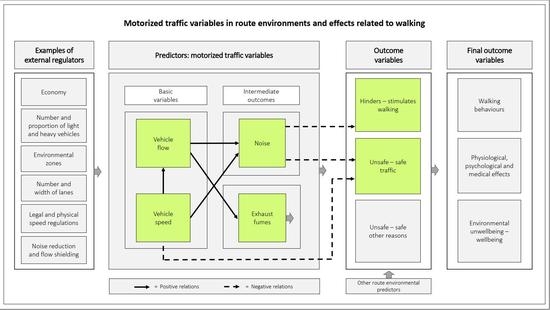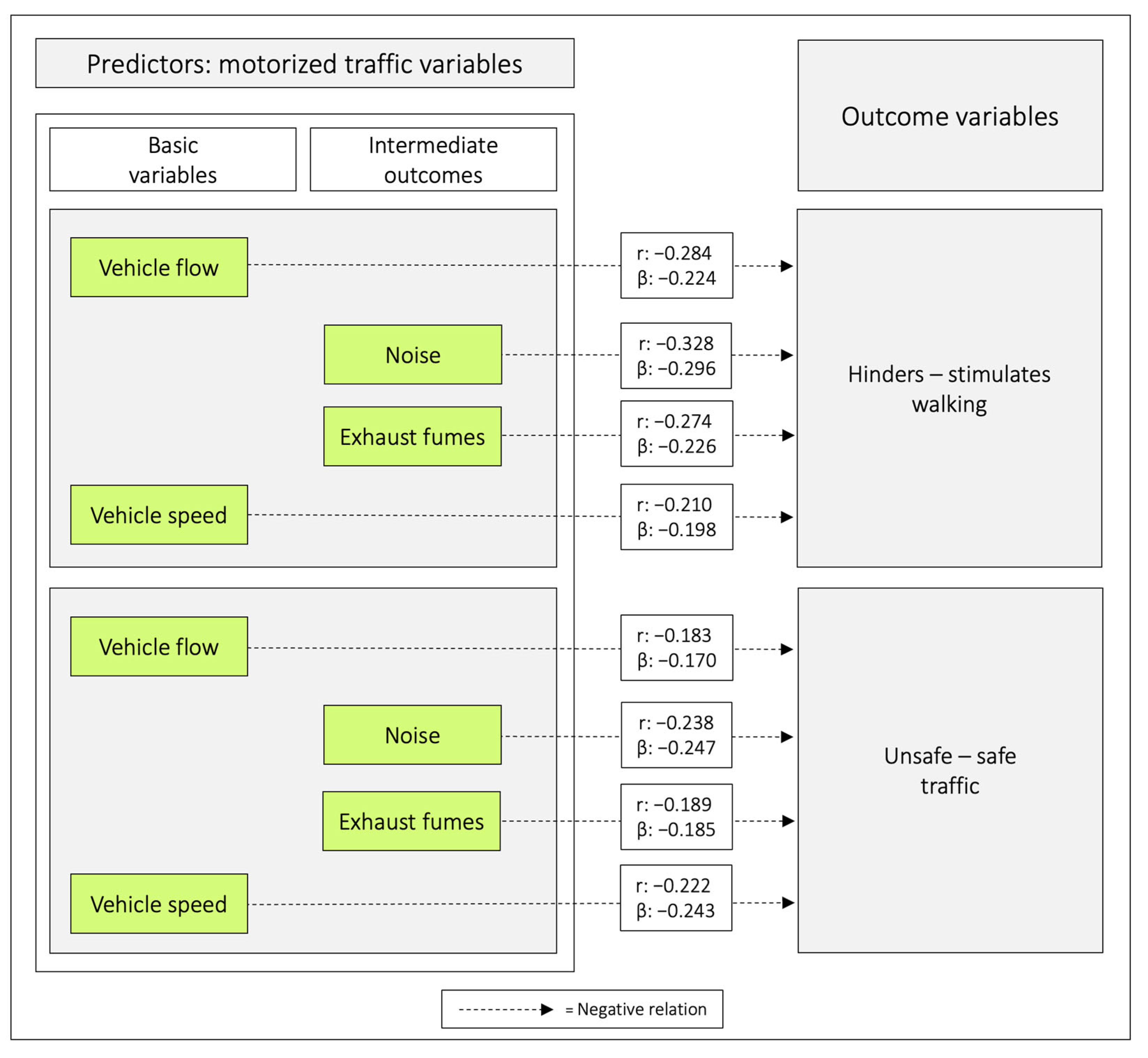Pedestrians’ Perceptions of Motorized Traffic Variables in Relation to Appraisals of Urban Route Environments
Abstract
1. Introduction
2. Method
2.1. Procedure and Participants
2.2. Descriptive Characteristics of the Participants
2.3. The Physically Active Commuting in Greater Stockholm Questionnaires (PACS Q1 and Q2)
The Active Commuting Route Environment Scale (ACRES)
2.4. Study Area
2.5. Statistical Analyses
3. Results
3.1. Perceptions of the Environmental Variables in Males and Females
3.2. Correlations between the Environmental Variables
3.3. Relations between the Predictor Variables
3.4. Relations between the Basic Variables Vehicle Speed and Vehicle Flow and the Intermediate Outcomes Noise and Exhaust Fumes
3.5. Relations between the Predictor Variables and the Outcome Hinders–Stimulates Walking
3.6. Relations between Combinations of Predictor Variables and the Outcome Hinders–Stimulates Walking
3.7. Relations between the Predictor Variables and the Outcome Unsafe–Safe Traffic
3.8. Relations between Combinations of Predictor Variables and the Outcome Unsafe–Safe Traffic
3.9. Mediation
3.10. A Graphic Illustration of Important Pathways Based on the Commuting Pedestrians’ Perceptions and Appraisals of Their Route Environments
4. Discussion
4.1. The Relationships between Perceptions of the Predictor Variables of Motor Traffic
4.2. Vehicle Speed and Vehicle Flow in Relation to Noise and Exhaust Fumes
4.3. The Traffic Variables in Relation to the Outcome Variable Hinders–Stimulates Walking
4.4. Comments on Relations between Noise and Vehicle flow
4.5. The Traffic Variables in Relation to the Outcome Variable Unsafe–Safe Traffic
5. Conclusions
Author Contributions
Funding
Institutional Review Board Statement
Informed Consent Statement
Data Availability Statement
Acknowledgments
Conflicts of Interest
Appendix A
| Distance | Duration | Speed | Frequency of Walking Trips in May | Total Number of Walking Trips over the Year * | |
|---|---|---|---|---|---|
| km | min | km·h−1 | trips·week−1 | ||
| Men | 2.98 ± 1.91 | 31.4 ± 18.4 | 5.64 ± 1.19 | 6.24 ± 5.89 | 274 ± 172 |
| (2.52–3.45) | (26.9–35.9) | (5.35–5.93) | (4.75–7.72) | (229–319) | |
| 67 | 66 | 66 | 63 | 59 | |
| Women | 2.91 ± 1.63 | 32.7 ± 17.6 | 5.27 ± 1.39 | 5.83 ± 4.99 | 279 ± 158 |
| (2.70–3.13) | (30.3–35.1) | (5.08–5.45) | (5.12–6.54) | (255–303) | |
| 220 | 213 | 213 | 192 | 165 |
| a.m. | 5–6 | >6–7 | >7–8 | >8–9 | >9–10 | >10 a.m.–<5 a.m. | |
|---|---|---|---|---|---|---|---|
| Men | n | 1 | 7 | 24 | 29 | 6 | 2 |
| (n = 69) | % | 1.4 | 10.1 | 34.8 | 42.0 | 8.7 | 2.9 |
| Women | n | 3 | 16 | 86 | 89 | 9 | 12 |
| (n = 215) | % | 1.4 | 7.4 | 40.0 | 41.4 | 4.2 | 5.6 |
| p.m. | 2–3 | >3–4 | >4–5 | >5–6 | >6–7 | >7–8 | >8 p.m.–<2 p.m. | |
|---|---|---|---|---|---|---|---|---|
| Men | n | 1 | 5 | 23 | 23 | 12 | 3 | 2 |
| (n = 69) | % | 1.4 | 7.2 | 33.3 | 33.3 | 17.4 | 4.3 | 2.9 |
| Women | n | 3 | 12 | 71 | 91 | 24 | 5 | 9 |
| (n = 215) | % | 1.4 | 5.6 | 33.0 | 42.3 | 11.2 | 2.3 | 4.2 |


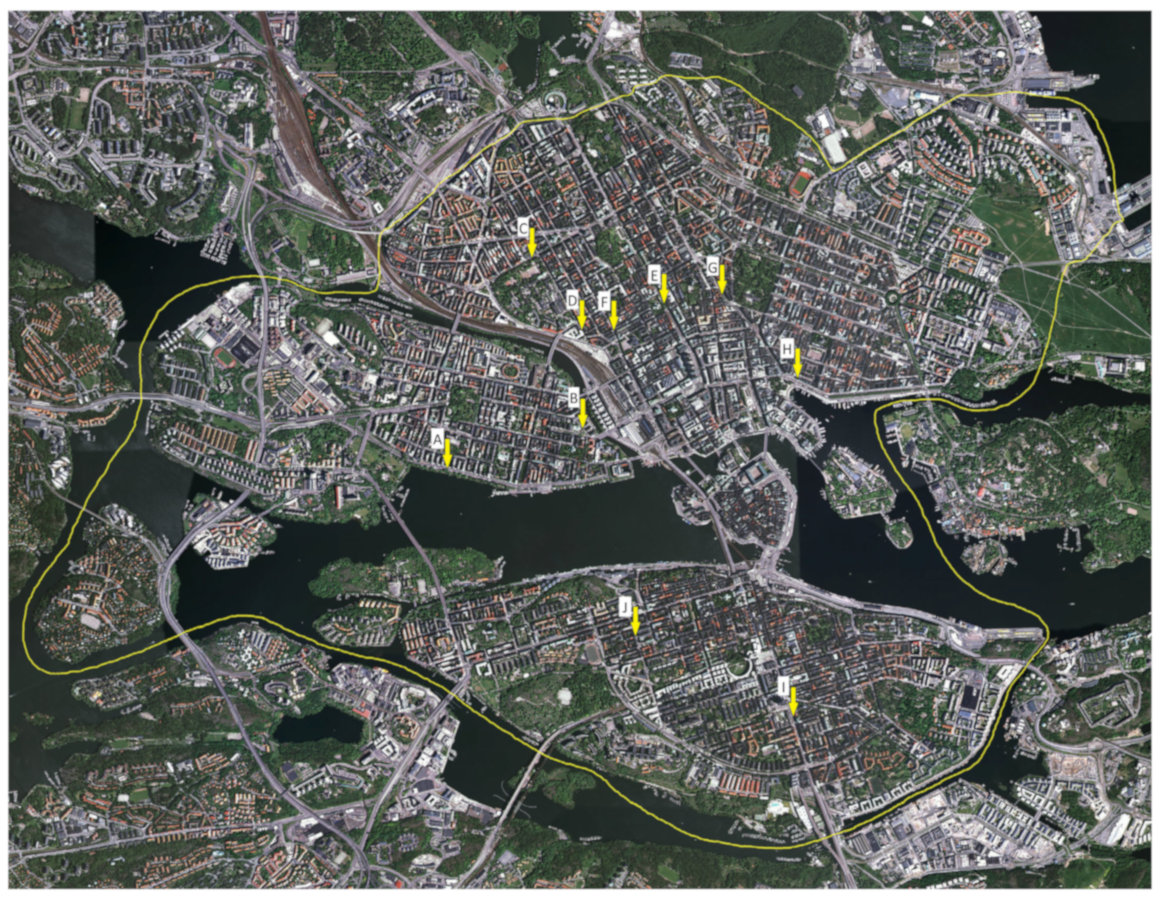
| Table | Predictors | Outcomes | VIF | Cook | Std. Residual > (±3 SD) | |||
|---|---|---|---|---|---|---|---|---|
| Mean | Maximum | Mean | Maximum | N | Maximum | |||
| 5 | Vehicle speed | Noise | 1.076 | 1.150 | 0.004 | 0.050 | 2 | −3.498 |
| 5 | Vehicle flow | Noise | 1.076 | 1.150 | 0.004 | 0.070 | – | – |
| 5 | Vehicle speed | Exhaust fumes | 1.076 | 1.150 | 0.004 | 0.056 | 2 | −3.134 |
| 5 | Vehicle flow | Exhaust fumes | 1.076 | 1.150 | 0.003 | 0.081 | 2 | −4.274 |
| 5 | Noise | Exhaust fumes | 1.070 | 1.151 | 0.004 | 0.061 | 3 | −3.977 |
| 5 | Vehicle speed | Vehicle flow | 1.076 | 1.150 | 0.004 | 0.052 | – | – |
| 6 | Vehicle speed Vehicle flow | Noise | 1.269 | 1.623 | 0.004 | 0.067 | 1 | 3.088 |
| 6 | Exhaust fumes | 1.269 | 1.623 | 0.004 | 0.086 | 2 | −4.300 | |
| 7 | Vehicle speed Vehicle flow | Hinders–stimulates walking | 1.269 | 1.623 | 0.004 | 0.062 | 2 | −3.149 |
| 7 | Noise Exhaust fumes | Hinders–stimulates walking | 1.470 | 2.244 | 0.004 | 0.063 | 2 | −3.215 |
| 7 | Vehicle speed Vehicle flow Noise Exhaust fumes | Hinders–stimulates walking | 1.875 | 3.300 | 0.004 | 0.050 | 2 | −3.211 |
| 8 | Vehicle speed Vehicle flow | Unsafe–safe traffic | 1.269 | 1.623 | 0.003 | 0.059 | 1 | −3.073 |
| 8 | Noise Exhaust fumes | Unsafe–safe traffic | 1.470 | 2.244 | 0.003 | 0.042 | 1 | −3.020 |
| 8 | Vehicle speed Vehicle flow Noise Exhaust fumes | Unsafe–safe traffic | 1.875 | 3.300 | 0.004 | 0.064 | – | – |
| A5 | Vehicle speed | Hinders–stimulates walking | 1.076 | 1.150 | 0.004 | 0.063 | 1 | −3.395 |
| A5 | Vehicle flow | Hinders–stimulates walking | 1.076 | 1.150 | 0.004 | 0.073 | 2 | −3.131 |
| A5 | Noise | Hinders–stimulates walking | 1.070 | 1.151 | 0.004 | 0.072 | 2 | −3.244 |
| A5 | Exhaust fumes | Hinders–stimulates walking | 1.077 | 1.150 | 0.004 | 0.070 | 2 | −3.123 |
| A6 | Vehicle speed | Unsafe–safe traffic | 1.076 | 1.150 | 0.003 | 0.062 | 1 | −3.051 |
| A6 | Vehicle flow | Unsafe–safe traffic | 1.076 | 1.150 | 0.003 | 0.061 | 1 | −3.012 |
| A6 | Noise | Unsafe–safe traffic | 1.070 | 1.151 | 0.003 | 0.037 | 1 | −3.023 |
| A6 | Exhaust fumes | Unsafe–safe traffic | 1.077 | 1.150 | 0.003 | 0.046 | – | – |
| Outcome | y-Intercept (95% CI) | p-Value | Predictor | Regression Coefficient, Unstandardized B (95% CI) | p-Value | Adj. R2 |
|---|---|---|---|---|---|---|
| Hinders–stimulates walking | 10.5 | <0.000 | Vehicle speed | −0.198 | <0.000 | 0.048 |
| (8.33–12.7) | (−0.308–−0.089) | |||||
| Hinders–stimulates walking | 11.1 | <0.000 | Vehicle flow | −0.224 | <0.000 | 0.082 |
| (9.03–13.2) | (−0.315–−0.134) | |||||
| Hinders–stimulates walking | 11.5 | <0.000 | Noise | −0.296 | <0.000 | 0.114 |
| (9.47–13.5) | (−0.395–−0.198) | |||||
| Hinders–stimulates walking | 11.1 | <0.000 | Exhaust fumes | −0.226 | <0.000 | 0.074 |
| (8.95–13.2) | (−0.322–−0.129) |
| Outcome | y-Intercept (95% CI) | p-Value | Predictor | Regression Coefficient, Unstandardized B (95% CI) | p-Value | Adj. R2 |
|---|---|---|---|---|---|---|
| Unsafe–safe traffic | 12.5 | <0.000 | Vehicle speed | −0.243 | <0.000 | 0.039 |
| (9.97–14.9) | (−0.369–−0.117) | |||||
| Unsafe–safe traffic | 11.9 | <0.000 | Vehicle flow | −0.170 | 0.002 | 0.024 |
| (9.44–14.4) | (−0.277–−0.063) | |||||
| Unsafe–safe traffic | 12.4 | <0.000 | Noise | −0.247 | <0.000 | 0.049 |
| (10.0–14.8) | (−0.364–−0.130) | |||||
| Unsafe–safe traffic | 12.0 | <0.000 | Exhaust fumes | −0.185 | 0.001 | 0.026 |
| (9.55–14.5) | (−0.298–−0.072) |
References
- Hall, K.S.; Hyde, E.T.; Bassett, D.R.; Carlson, S.A.; Carnethon, M.R.; Ekelund, U.; Evenson, K.R.; Galuska, D.A.; Kraus, W.E.; Lee, I.M.; et al. Systematic review of the prospective association of daily step counts with risk of mortality, cardiovascular disease, and dysglycemia. Int. J. Behav. Nutr. Phys. Act. 2020, 17, 78. [Google Scholar] [CrossRef]
- Kelly, P.; Kahlmeier, S.; Gotschi, T.; Orsini, N.; Richards, J.; Roberts, N.; Scarborough, P.; Foster, C. Systematic review and meta-analysis of reduction in all-cause mortality from walking and cycling and shape of dose response relationship. Int. J. Behav. Nutr. Phys. Act. 2014, 11, 132. [Google Scholar] [CrossRef] [PubMed]
- Morris, J.N.; Hardman, A.E. Walking to health. Sports Med. 1997, 23, 306–332. [Google Scholar] [CrossRef] [PubMed]
- Hallal, P.C.; Andersen, L.B.; Bull, F.C.; Guthold, R.; Haskell, W.; Ekelund, U. Global physical activity levels: Surveillance progress, pitfalls, and prospects. Lancet 2012, 380, 247–257. [Google Scholar] [CrossRef] [PubMed]
- Saelens, B.E.; Sallis, J.F.; Black, J.B.; Chen, D. Neighborhood-Based Differences in Physical Activity: An Environment Scale Evaluation. Am. J. Public Health 2003, 93, 1552–1558. [Google Scholar] [CrossRef] [PubMed]
- Oakes, J.M.; Forsyth, A.; Schmitz, K.H. The effects of neighborhood density and street connectivity on walking behavior: The Twin Cities walking study. Epidemiol. Perspect. Innov. 2007, 4, 16. [Google Scholar] [CrossRef] [PubMed]
- Brownson, R.C.; Chang, J.J.; Eyler, A.A.; Ainsworth, B.E.; Kirtland, K.A.; Saelens, B.E.; Sallis, J.F. Measuring the Environment for Friendliness Toward Physical Activity: A Comparison of the Reliability of 3 Questionnaires. Am. J. Public Health 2004, 94, 473–483. [Google Scholar] [CrossRef]
- Humpel, N.; Owen, N.; Iverson, D.; Leslie, E.; Bauman, A. Perceived Environment Attributes, Residential Location, and Walking for Particular Purposes. Am. J. Prev. Med. 2004, 26, 119–125. [Google Scholar] [CrossRef] [PubMed]
- Anciaes, P.R.; Stockton, J.; Ortegon, A.; Scholes, S. Perceptions of road traffic conditions along with their reported impacts on walking are associated with wellbeing. Travel Behav. Soc. 2019, 15, 88–101. [Google Scholar] [CrossRef]
- Foster, C.; Hillsdon, M.; Thorogood, M. Environmental perceptions and walking in English adults. J. Epidemiol. Community Health 2004, 58, 924–928. [Google Scholar] [CrossRef]
- Van Cauwenberg, J.; Van Holle, V.; Simons, D.; Deridder, R.; Clarys, P.; Goubert, L.; Nasar, J.; Salmon, J.; De Bourdeaudhuij, I.; Deforche, B. Environmental factors influencing older adults’ walking for transportation: A study using walk-along interviews. Int. J. Behav. Nutr. Phys. Act. 2012, 9, 85. [Google Scholar] [CrossRef]
- Lee, C.; Moudon, A.V. Correlates of Walking for Transportation or Recreation Purposes. J. Phys. Act. Health 2006, 3, S77–S98. [Google Scholar] [CrossRef]
- Wahlgren, L.; Schantz, P. Bikeability and methodological issues using the active commuting route environment scale (ACRES) in a metropolitan setting. BMC Med. Res. Methodol. 2011, 11, 6. [Google Scholar] [CrossRef]
- Wahlgren, L.; Stigell, E.; Schantz, P. The active commuting route environment scale (ACRES): Development and evaluation. Int. J. Behav. Nutr. Phys. Act. 2010, 7, 58. [Google Scholar] [CrossRef] [PubMed]
- Schantz, P. Physical Activity Behaviours and Environmental Well-Being in a Spatial Context; Swedish National Defence College: Stockholm, Sweden; Norwegian University of Science and Technology (NTNU): Trondheim, Norway; Universität Bonn: Bonn, Germany, 2014; p. 150. ISBN 978-91-86137-30-4. [Google Scholar]
- Alfonzo, M.A. To Walk Or Not To Walk? The Hierarchy of Walking Needs. Environ. Behav. 2016, 37, 808–836. [Google Scholar] [CrossRef]
- Van Cauwenberg, J.; Clarys, P.; De Bourdeaudhuij, I.; Van Holle, V.; Verte, D.; De Witte, N.; De Donder, L.; Buffel, T.; Dury, S.; Deforche, B. Physical environmental factors related to walking and cycling in older adults: The Belgian aging studies. BMC Public Health 2012, 12, 142. [Google Scholar] [CrossRef] [PubMed]
- Schantz, P. De Upplevda Landskapen för Cykling. Påverkan på Hälsan (The Perceived Landscapes for Cycling. Impact on Health); Trafikverket: Borlänge, Sweden, 2018; p. 25. ISBN 978-91-7725-375-4.
- Panter, J.; Griffin, S.; Ogilvie, D. Active commuting and perceptions of the route environment: A longitudinal analysis. Prev. Med. 2014, 67, 134–140. [Google Scholar] [CrossRef] [PubMed]
- Buecker, S.; Simacek, T.; Ingwersen, B.; Terwiel, S.; Simonsmeier, B.A. Physical activity and subjective well-being in healthy individuals: A meta-analytic review. Health Psychol. Rev. 2021, 15, 574–592. [Google Scholar] [CrossRef]
- Kumar, P.; Nigam, S.P.; Kumar, N. Vehicular traffic noise modeling using artificial neural network approach. Transp. Res. Part C Emerg. Technol. 2014, 40, 111–122. [Google Scholar] [CrossRef]
- Naturvårdsverket. Vägtrafikbuller: Nordisk Beräkningsmodell, Reviderad 1996 (Road Traffic Noise: Nordic Calculation Model, Revised 1996); Naturvårdsverket: Stockholm, Sweden, 1996; p. 5. ISBN 91-620-4653-5. [Google Scholar]
- Wahlgren, L.; Schantz, P. Exploring bikeability in a metropolitan setting: Stimulating and hindering factors in commuting route environments. BMC Public Health 2012, 12, 168. [Google Scholar] [CrossRef]
- Stigell, E. Assessment of Active Commuting Behavior—Walking and Bicycling in Greater Stockholm (Dissertation); Örebro University: Örebro, Sweden, 2011; pp. 65–69. ISBN 978-91-7668-805-2. [Google Scholar]
- Schantz, P.; Salier Eriksson, J.; Rosdahl, H. The heart rate method for estimating oxygen uptake: Analyses of reproducibility using a range of heart rates from cycle commuting. PLoS ONE 2019, 14, e0219741. [Google Scholar] [CrossRef]
- Stigell, E.; Schantz, P. Active Commuting Behaviors in a Nordic Metropolitan Setting in Relation to Modality, Gender, and Health Recommendations. Int. J. Environ. Res. Public Health 2015, 12, 15626–15648. [Google Scholar] [CrossRef]
- Tabachnik, B.; Fidell, L. Using Multivariate Statistics, 6th ed.; Pearson Education: Boston, MA, USA, 2013; pp. 88–90. ISBN 978-0-205-84957-4. [Google Scholar]
- Field, A. Discovering Statistics Using IBM SPSS Statistics, 5th ed.; SAGE Publications: London, UK, 2018; pp. p. 402, p. 383. ISBN 978-1-5264-1952-1. [Google Scholar]
- Hayes, A.F. The PROCESS macro for SPSS, SAS, and R. Available online: http://www.processmacro.org/index.html (accessed on 2 December 2022).
- Winters, M.; Teschke, K. Route preferences among adults in the near market for bicycling: Findings of the cycling in cities study. Am. J. Health Promot. 2010, 25, 40–47. [Google Scholar] [CrossRef] [PubMed]
- Marquart, H.; Stark, K.; Jarass, J. How are air pollution and noise perceived en route? Investigating cyclists’ and pedestrians’ personal exposure, wellbeing and practices during commute. J. Transp. Health 2022, 24, 101325. [Google Scholar] [CrossRef]
- McGinn, A.P.; Evenson, K.R.; Herring, A.H.; Huston, S.L.; Rodriguez, D.A. Exploring Associations between Physical Activity and Perceived and Objective Measures of the Built Environment. J. Urban Health 2007, 84, 162–184. [Google Scholar] [CrossRef]
- Annear, M.J.; Cushman, G.; Gidlow, B. Leisure time physical activity differences among older adults from diverse socioeconomic neighborhoods. Health Place 2009, 15, 482–490. [Google Scholar] [CrossRef]
- Herrmann-Lunecke, M.G.; Mora, R.; Vejares, P. Perception of the built environment and walking in pericentral neighbourhoods in Santiago, Chile. Travel Behav. Soc. 2021, 23, 192–206. [Google Scholar] [CrossRef]
- Foraster, M.; Eze, I.C.; Vienneau, D.; Brink, M.; Cajochen, C.; Caviezel, S.; Heritier, H.; Schaffner, E.; Schindler, C.; Wanner, M.; et al. Long-term transportation noise annoyance is associated with subsequent lower levels of physical activity. Environ. Int. 2016, 91, 341–349. [Google Scholar] [CrossRef] [PubMed]
- Kardell, L.; Pehrson, K. Stockholmarnas Friluftsliv: Vanor och Önskemål: En Enkät- och Intervjustudie (Stockholmers Outdoors: Use of Nature Areas: A Mail Questionnaire and a Home Interview Study); Swedish University of Agricultural Sciences: Uppsala, Sweden, 1978; pp. 1–122. ISBN 91-576-0003-1. [Google Scholar]
- WHO. Walking and Cycling: Latest Evidence to Support Policy-Making and Practice; World Health Organization: Copenhagen, Denmark, 2022; p. 60. ISBN 978-92-890-5788-2. [Google Scholar]
- Iversen, L.; Skov, R.S. Noise from Electric Vehicles—Measurements; Danish Road Directorate: Copenhagen, Denmark, 2015; p. 35.
- Garay-Vega, L.; Hastings, A.; Pollard, J.K.; Zuschlag, M.; Stearns, M.D. Quieter Cars and the Safety of Blind Pedestrians: Phase I; National Highway Traffic Safety Administration: Washington, DC, USA, 2010; p. 3.
- Wahlgren, L.; Schantz, P. Exploring bikeability in a suburban metropolitan area using the Active Commuting Route Environment Scale (ACRES). Int. J. Environ. Res. Public Health 2014, 11, 8276–8300. [Google Scholar] [CrossRef]
- Schantz, P.; Ceci, R. (The Unit for Road Safety, Department of Planning, Swedish Transport Administration, Borlänge, Sweden). Personal communication. 2021. [Google Scholar]
- Dadpour, S.; Pakzad, J.; Khankeh, H. Understanding the Influence of Environment on Adults’ Walking Experiences: A Meta-Synthesis Study. Int. J. Environ. Res. Public Health 2016, 13, 731. [Google Scholar] [CrossRef] [PubMed]
- Sugiyama, T.; Neuhaus, M.; Cole, R.; Giles-Corti, B.; Owen, N. Destination and Route Attributes Associated with Adults’ Walking: A Review. Med. Sci. Sports Exerc. 2012, 44, 1275–1286. [Google Scholar] [CrossRef] [PubMed]
- WHO. Global Status Report on Road Safety 2018: Summary; World Health Organization: Geneva, Switzerland, 2018; p. 8. [Google Scholar]
- Andersson, D.; Wahlgren, L.; Schantz, P. Pedestrians´ perceptions of route environments in relation to deterring or facilitating walking. Front. Public Health 2023, 10, 1012222. [Google Scholar] [CrossRef]
- City of Stockholm Transport Department. Analys av biltrafiken inför Stockholmsförsöket—April 2005 (Analysis of Car Traffic Before The Stockholm Trial—April 2005); City of Stockholm Transport Department: Stockholm, Sweden, 2005; pp. 1–53. [Google Scholar]
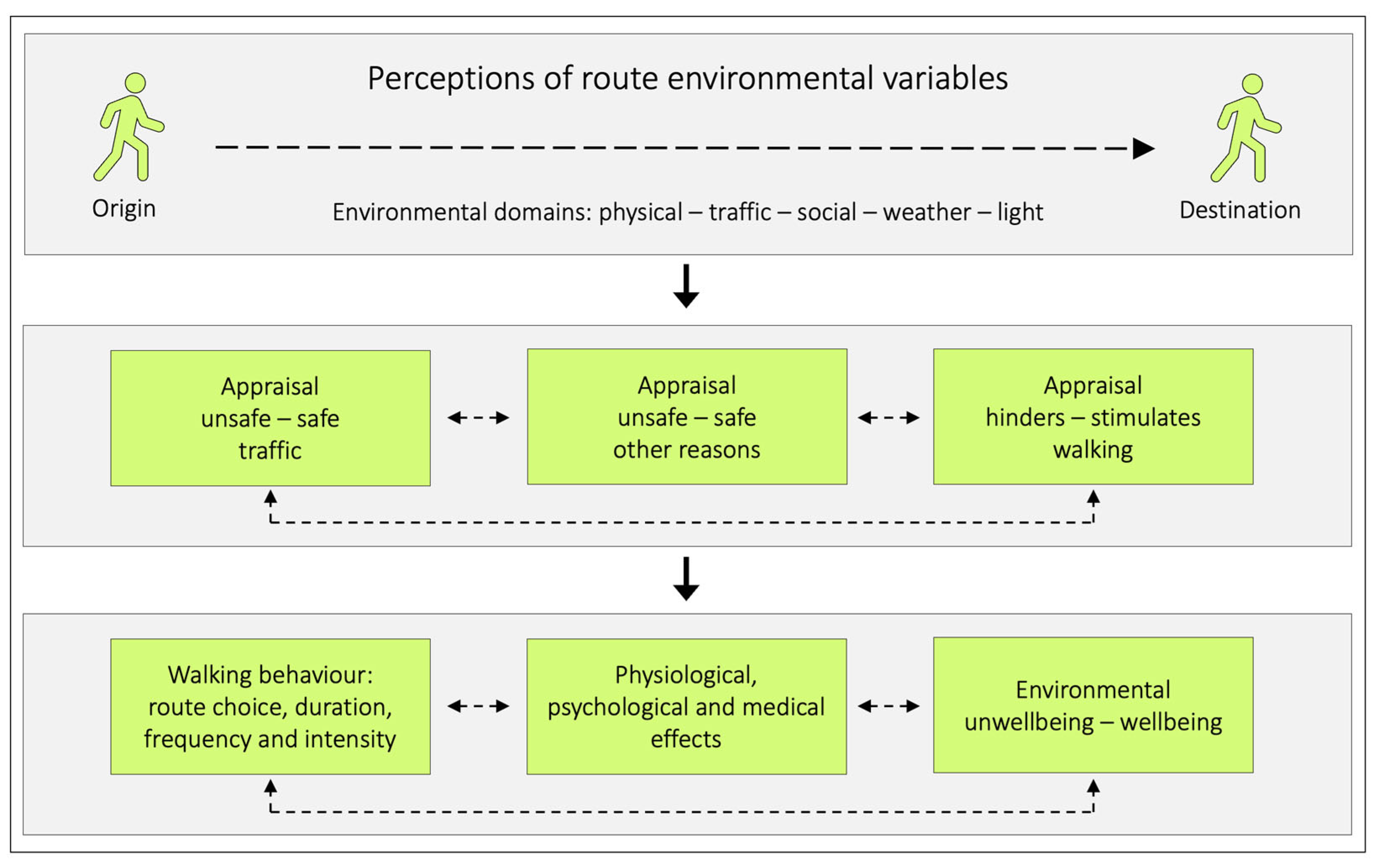
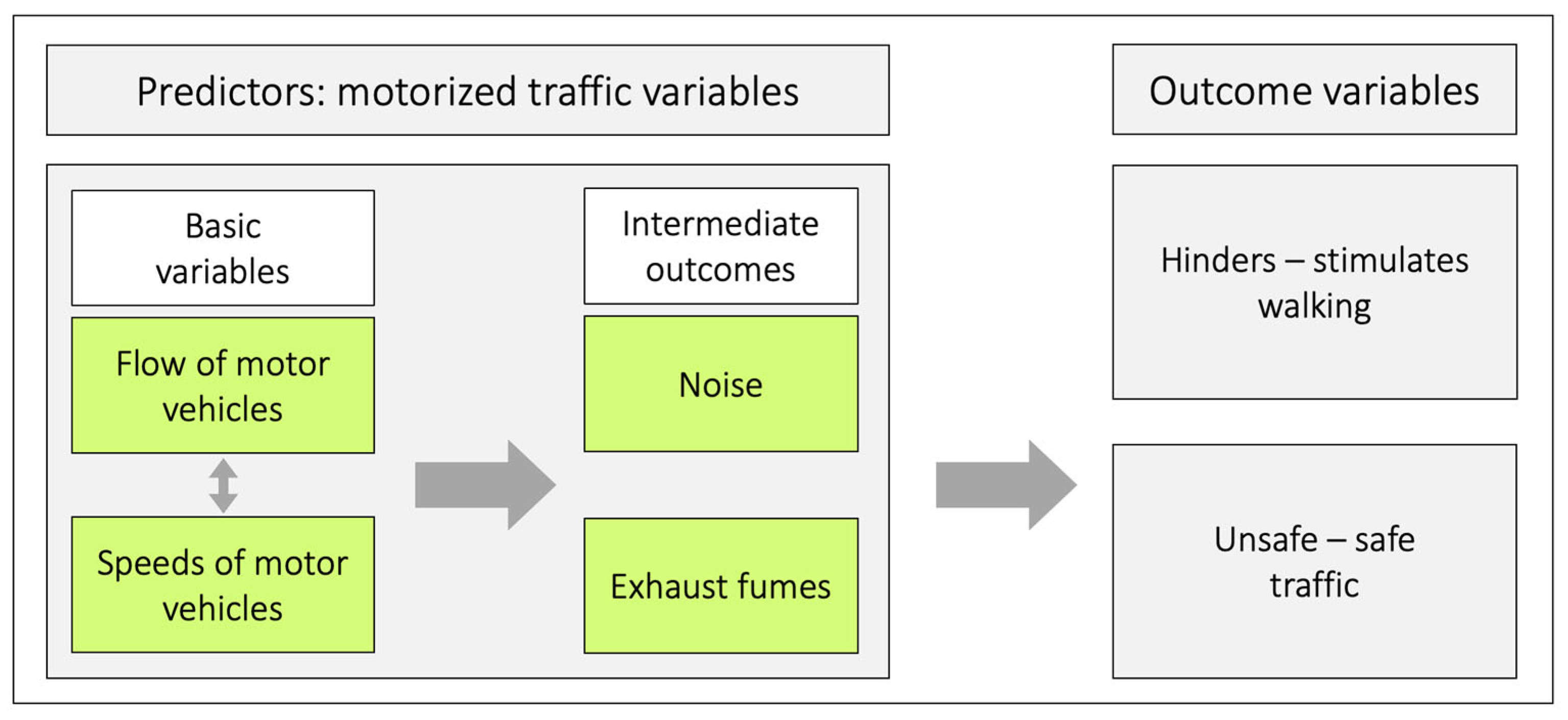
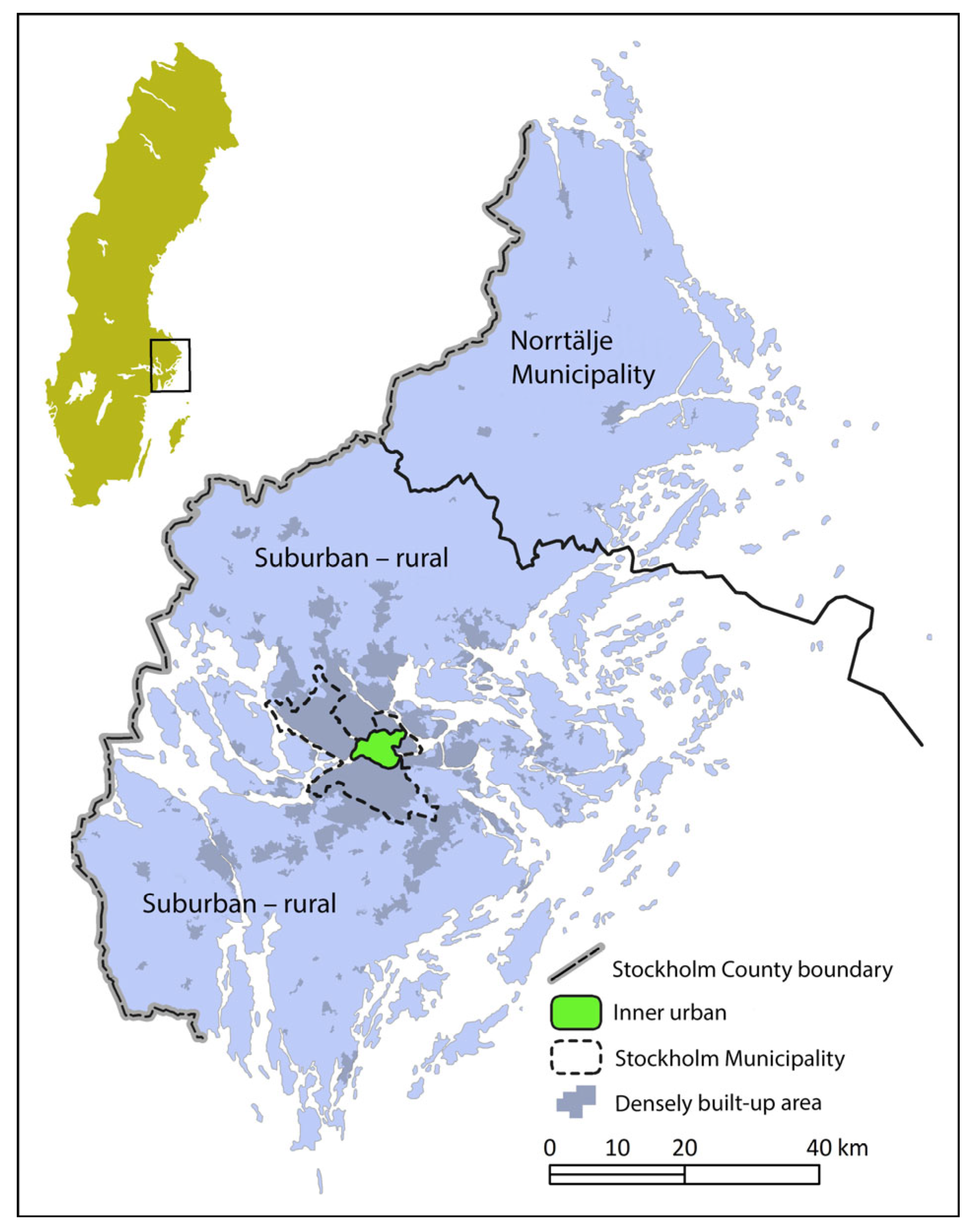
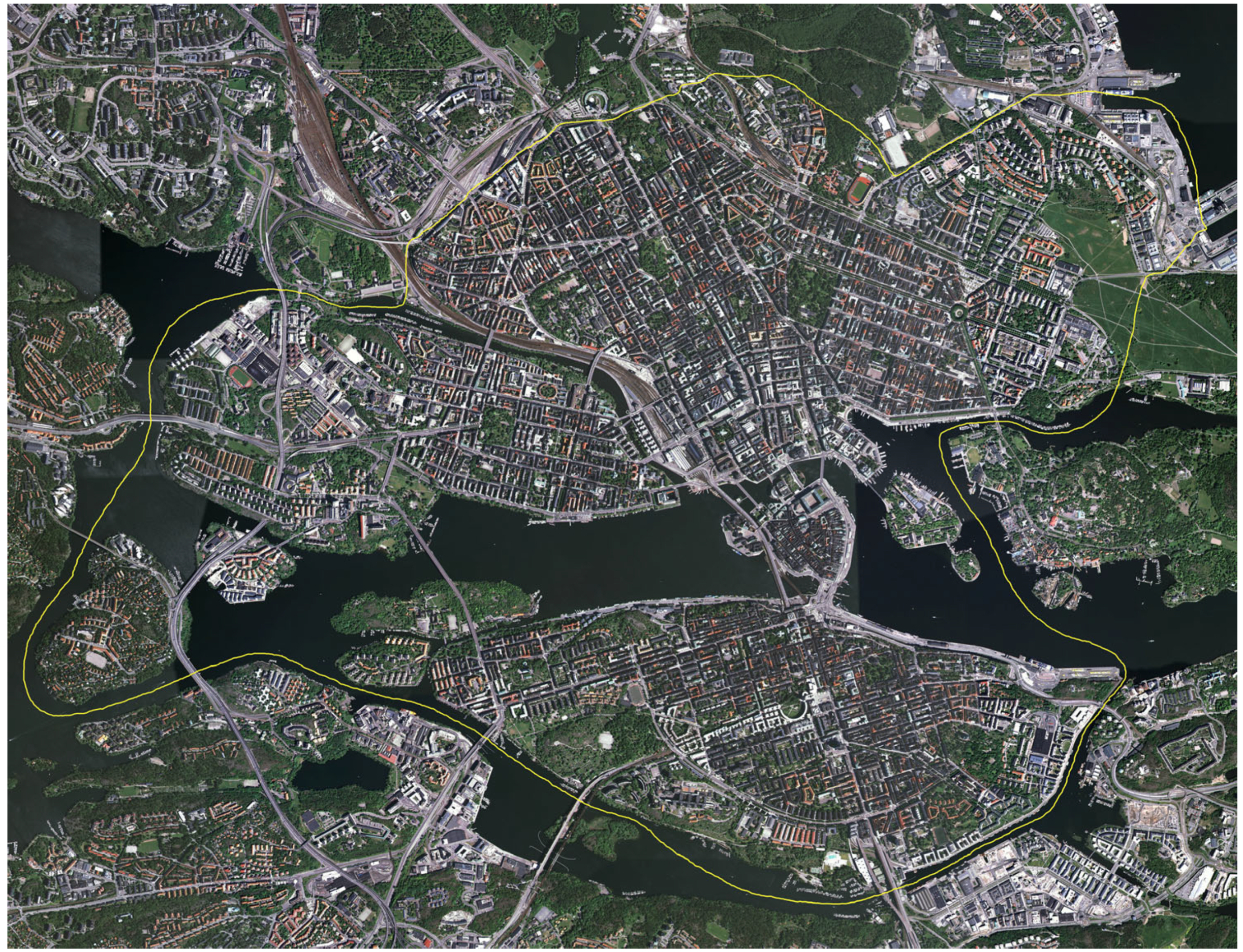
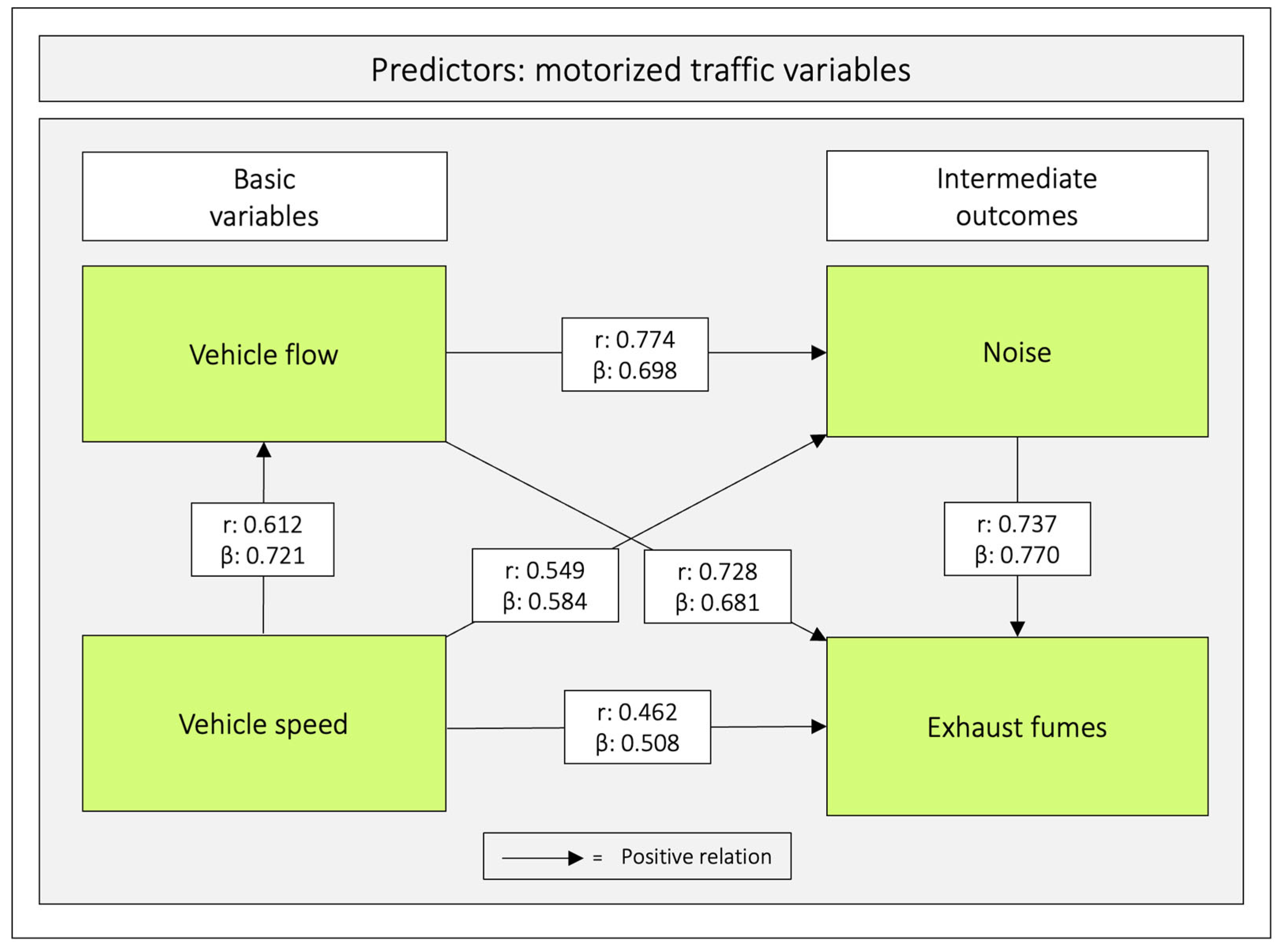
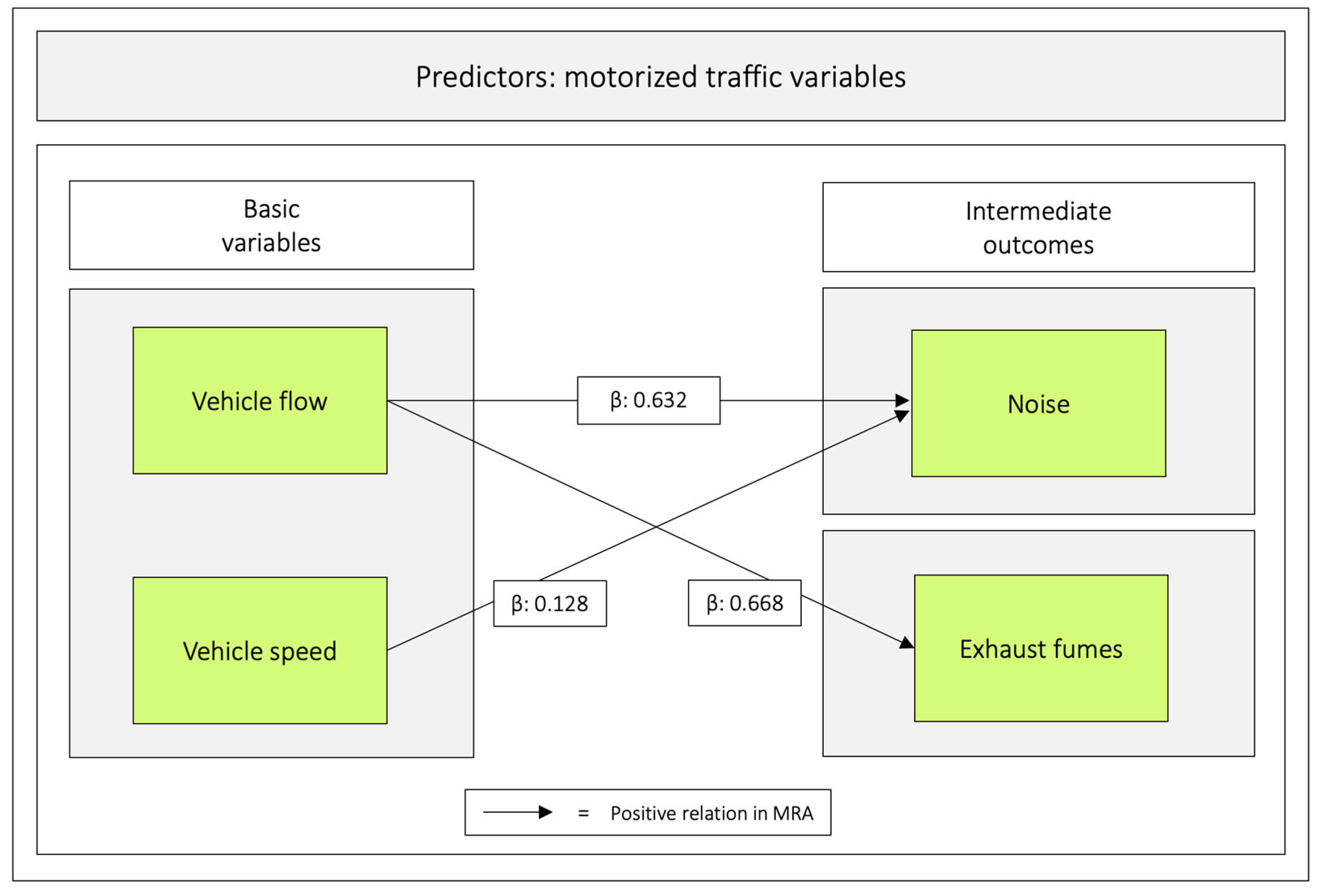
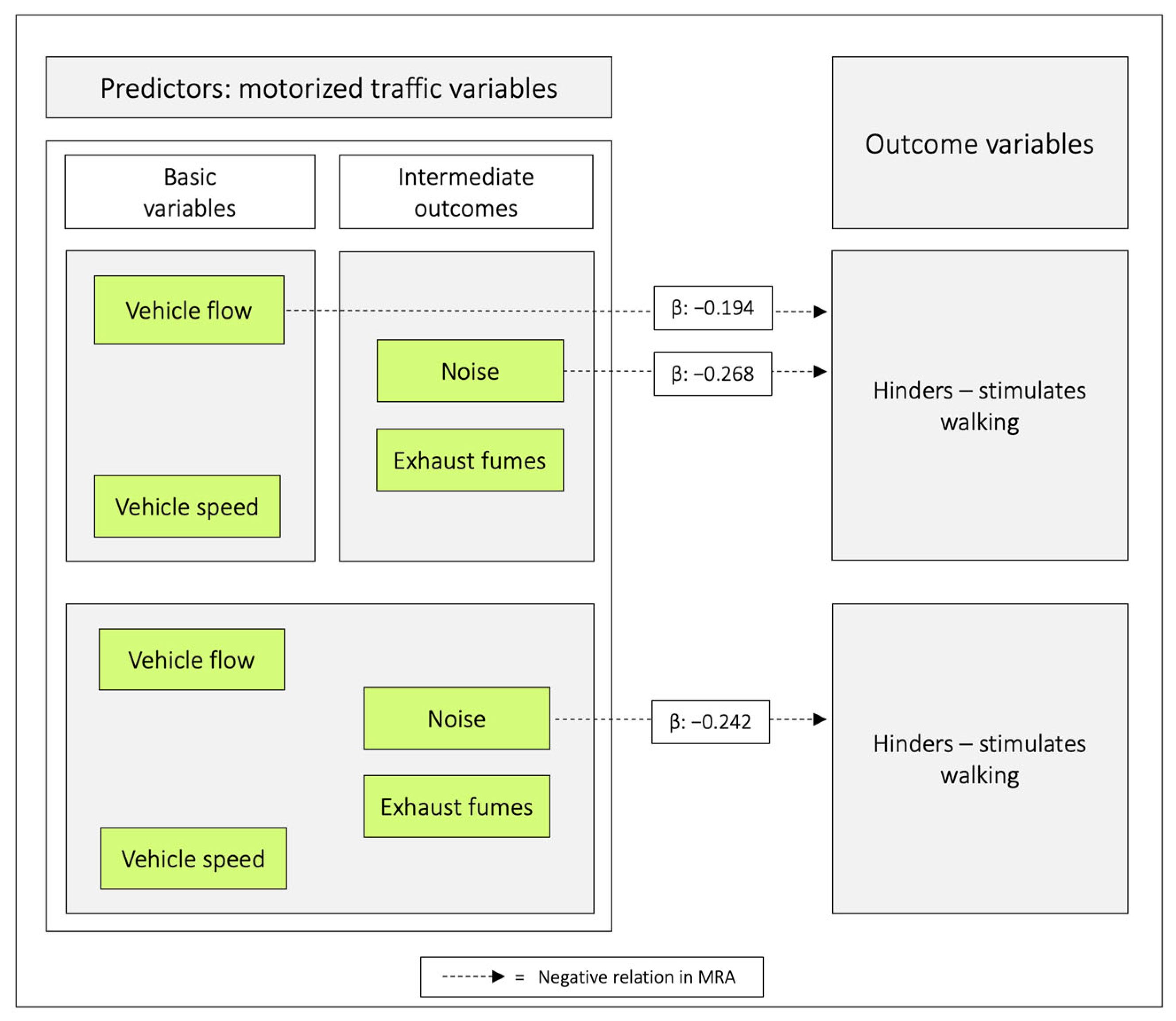
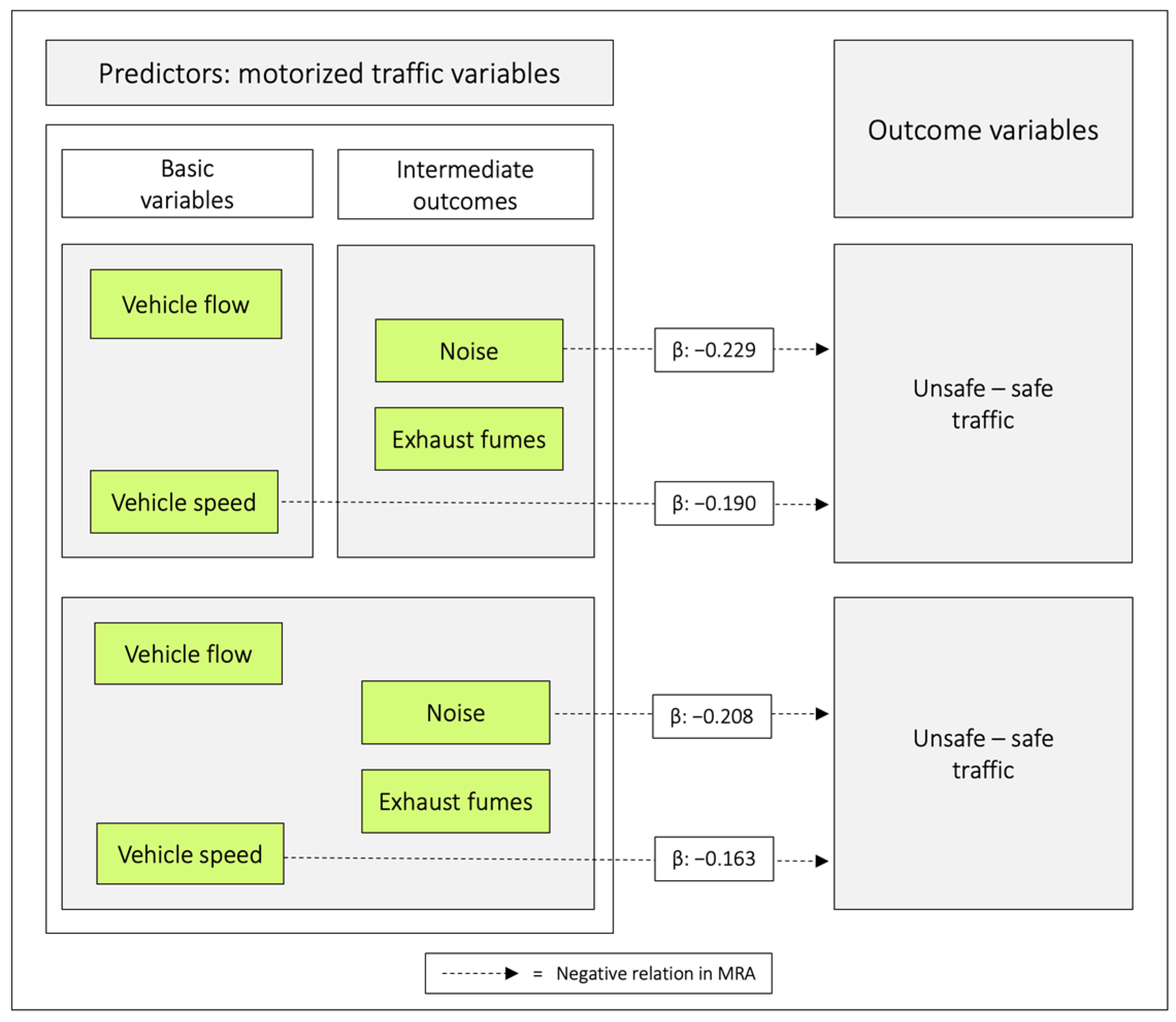
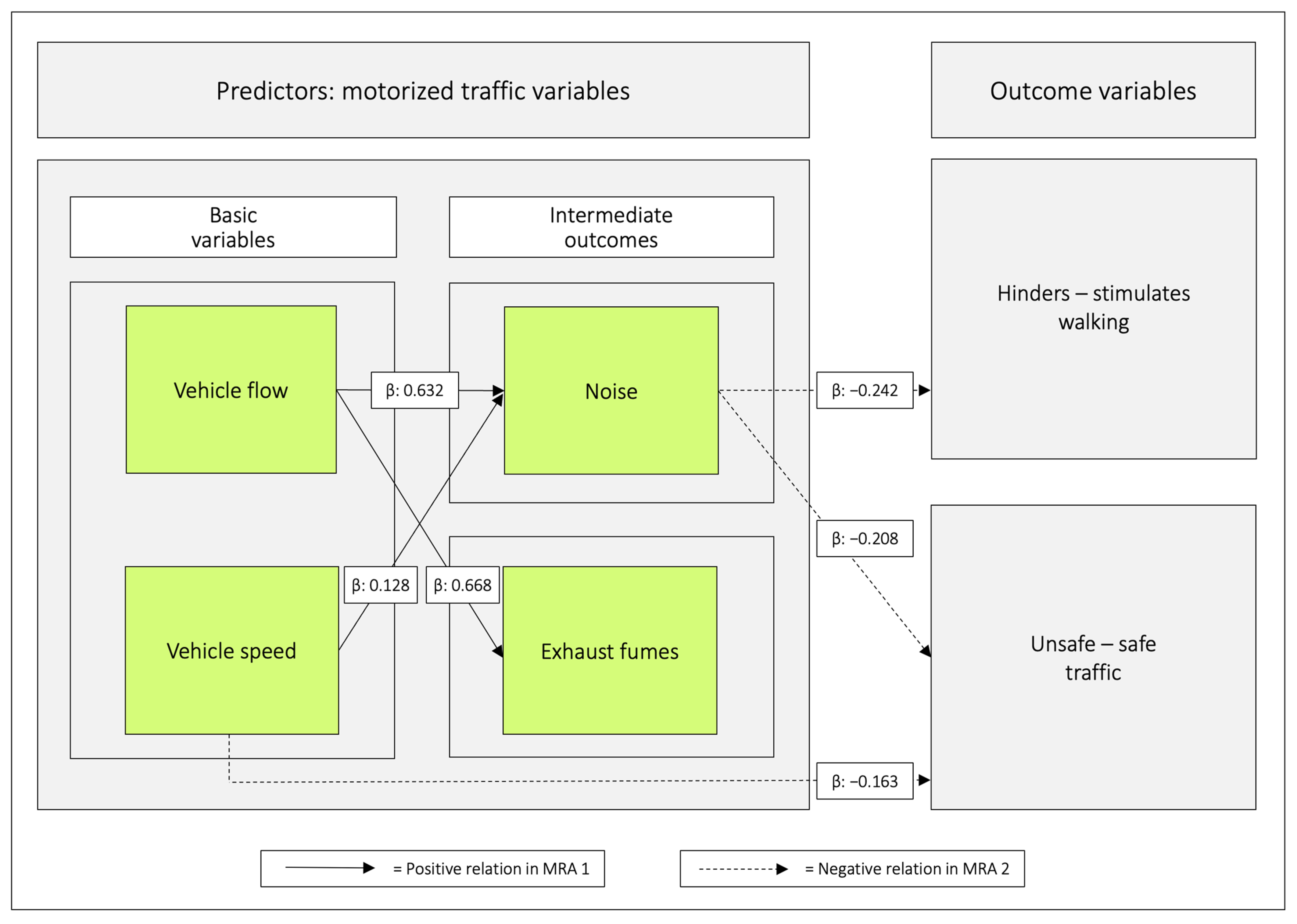
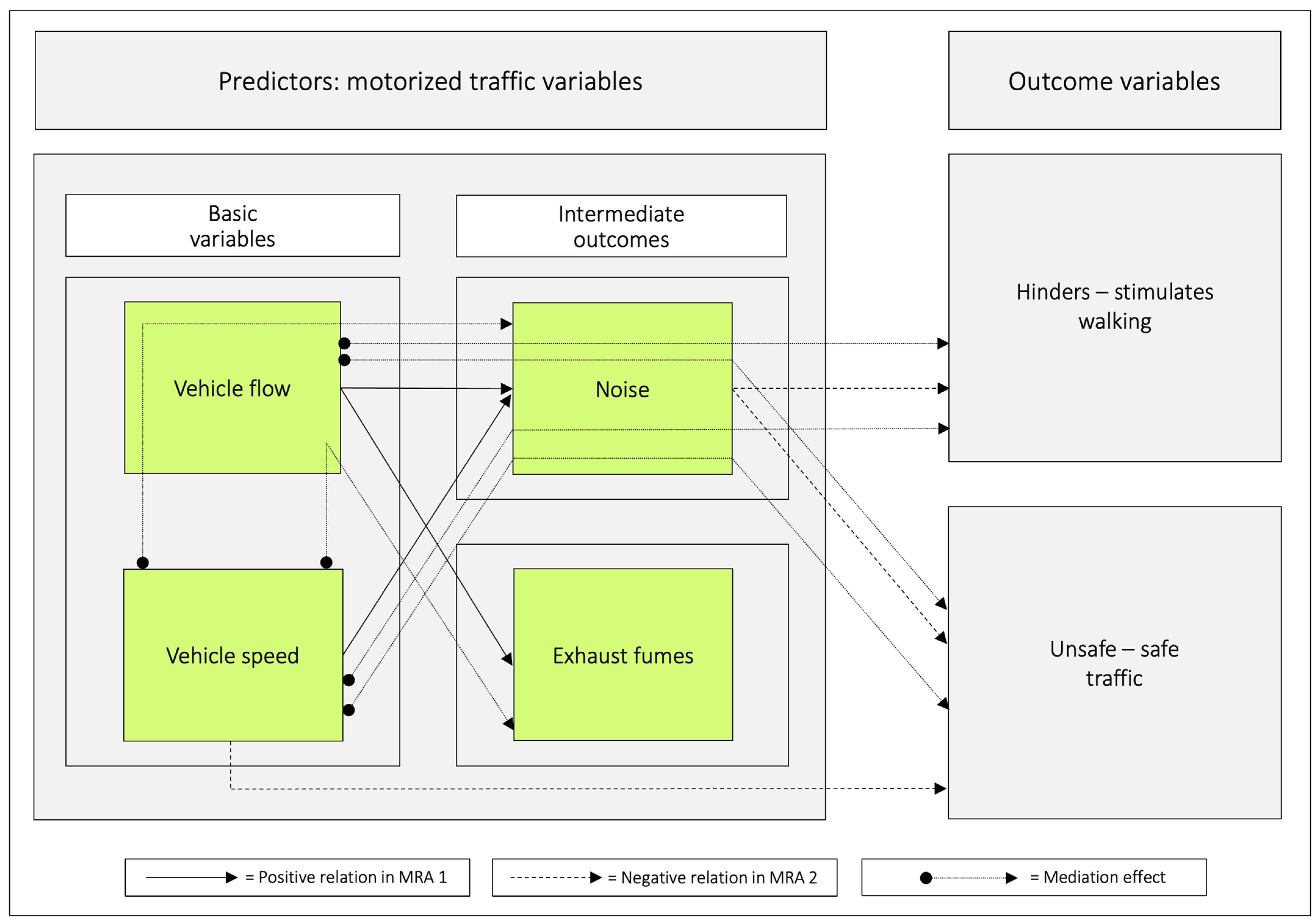

| Background Factors | |
|---|---|
| Females **, % | 77 |
| Age in years **, mean ± SD | 49.5 ± 10.4 |
| Weight in kg, mean ± SD | 68.4 ± 10.6 |
| Height in cm, mean ± SD | 171.1 ± 8.2 |
| Body mass index, mean ± SD | 23.3 ± 2.7 |
| Gainful employment, % | 97 |
| Educated at university level **, % | 79 |
| Income **: | |
| ≤25,000 SEK *** a month, % | 37 |
| 25,001–30,000 SEK *** a month, % | 27 |
| ≥30,001 SEK *** a month, % | 35 |
| Participant and both parents born in Sweden, % | 80 |
| Having a driver’s licence, % | 89 |
| Usually access to a car, % | 56 |
| Leaving home 7–9 a.m. to walk to place of work or study, % | 80 |
| Leaving place of work or study 4–6 p.m. to walk home, % | 73 |
| Number of walking commuting trips per year ****, mean ± SD | 278 ± 162 |
| Overall physical health either good or very good, % | 77 |
| Overall mental health either good or very good, % | 85 |
| Question | 15-Point Response Scale | Variable Name | |||
|---|---|---|---|---|---|
| 1 | 15 | ||||
| Environmental Variables | Outcome Variables | Do you think that, on the whole, the environment you walk in hinders/stimulates your commuting? | Hinders a lot | Stimulates a lot | Hinders–stimulates walking |
| How unsafe/safe do you feel in traffic as a pedestrian along your route? | Very unsafe | Very safe | Unsafe–safe traffic | ||
| Predictor Variables | How do you find the speeds of motor vehicles (taxis, lorries, ordinary cars, buses) along your route? | Very low | Very high | Speeds of motor vehicles | |
| How do you find the flow of motor vehicles (number of cars) along your route? | Very low | Very high | Flow of motor vehicles | ||
| How do you find the noise levels along your route? | Very low | Very high | Noise | ||
| How do you find the exhaust fume levels along your route? | Very low | Very high | Exhaust fumes | ||
| Outcome Variables | Predictor Variables | |||||
|---|---|---|---|---|---|---|
| Hinders–Stimulates Walking | Unsafe–Safe Traffic | Vehicle Speed | Vehicle Flow | Noise | Exhaust Fumes | |
| Men (n = 69) | 10.4 | 11.0 | 8.90 | 9.80 | 9.51 | 9.30 |
| 3.04 | 3.18 | 2.74 | 3.30 | 3.34 | 3.45 | |
| (9.70–11.2) | (10.2–11.7) | (8.24–9.56) | (9.01–10.6) | (8.71–10.3) | (8.47–10.1) | |
| Women (n = 225) | 10.4 | 10.8 | 9.77 * | 10.3 | 9.98 | 9.88 |
| 2.95 | 3.47 | 3.15 | 3.76 | 3.26 | 3.45 | |
| (10.1–10.8) | (10.4–11.3) | (9.36–10.2) | (9.83–10.8) | (9.55–10.4) | (9.43–10.3) | |
| Hinders–Stimulates Walking | Unsafe–Safe Traffic | Vehicle Speed | Vehicle Flow | Noise | Exhaust Fumes | |
|---|---|---|---|---|---|---|
| Hinders– stimulates walking | — | |||||
| Unsafe–safe traffic | 0.313 * | — | ||||
| Vehicle speed | −0.210 * | −0.222 * | — | |||
| Vehicle flow | −0.284 * | −0.183 * | 0.612 * | — | ||
| Noise | −0.328 * | −0.238 * | 0.549 * | 0.774 * | — | |
| Exhaust fumes | −0.274 * | −0.189 * | 0.462 * | 0.728 * | 0.737 * | — |
| Outcome | y-Intercept (95% CI) | p-Value | Predictor | Regression Coefficient, Unstandardized B (95% CI) | p-Value | Adj. R2 |
|---|---|---|---|---|---|---|
| Noise | 4.32 | <0.000 | Vehicle speed | 0.584 | <0.000 | 0.292 |
| (2.26–6.38) | (0.480–0.688) | |||||
| Noise | 2.00 | 0.011 | Vehicle flow | 0.698 | <0.000 | 0.595 |
| (0.46–3.53) | (0.631–0.764) | |||||
| Exhaust fumes | 6.69 | <0.000 | Vehicle speed | 0.508 | <0.000 | 0.213 |
| (4.40–8.97) | (0.392–0.623) | |||||
| Exhaust fumes | 3.72 | <0.000 | Vehicle flow | 0.681 | <0.000 | 0.526 |
| (1.97–5.47) | (0.606–0.757) | |||||
| Exhaust fumes | 4.00 | <0.000 | Noise | 0.770 | <0.000 | 0.547 |
| (2.32–5.69) | (0.688–0.852) | |||||
| Vehicle flow | 4.61 | <0.000 | Vehicle speed | 0.721 | <0.000 | 0.373 |
| (2.46–6.77) | (0.612–0.830) |
| Intermediate Outcome | y-Intercept (95% CI) | p-Value | Predictor | Regression Coefficient, Unstandardized B (95% CI) | p-Value | Adj. R2 |
|---|---|---|---|---|---|---|
| Noise | 1.40 (−0.19–2.99) | 0.083 | Vehicle speed | 0.128 | 0.011 | 0.602 |
| (0.030–0.226) | ||||||
| Vehicle flow | 0.632 | <0.000 | ||||
| (0.549–0.715) | ||||||
| Exhaust fumes | 3.60 (1.77–5.43) | <0.000 | Vehicle speed | 0.026 | 0.657 | 0.525 |
| (−0.088–0.139) | ||||||
| Vehicle flow | 0.668 | <0.000 | ||||
| (0.573–0.764) |
| Outcome | y-Intercept (95% CI) | p-Value | Predictor | Regression Coefficient, Unstandardized B (95% CI) | p-Value | Adj. R2 |
|---|---|---|---|---|---|---|
| Hinders–stimulates walking | 11.4 (9.20–13.6) | <0.000 | Vehicle speed | −0.058 | 0.398 | 0.081 |
| (−0.194–0.077) | ||||||
| Vehicle flow | −0.194 | 0.001 | ||||
| (−0.308–−0.080) | ||||||
| Hinders–stimulates walking | 11.6 (9.54–13.7) | <0.000 | Noise | −0.268 | <0.000 | 0.111 |
| (−0.413–−0.122) | ||||||
| Exhaust fumes | −0.037 | 0.600 | ||||
| (−0.177–0.102) | ||||||
| Hinders–stimulates walking | 11.8 (9.61–14.0) | <0.000 | Vehicle speed | −0.026 | 0.700 | 0.106 |
| (−0.162–0.109) | ||||||
| Vehicle flow | −0.024 | 0.771 | ||||
| (−0.184–0.137) | ||||||
| Noise | −0.242 | 0.006 | ||||
| (−0.415–−0.070) | ||||||
| Exhaust fumes | −0.026 | 0.732 | ||||
| (−0.176–0.124) |
| Outcome | y-Intercept (95% CI) | p-Value | Predictor | Regression Coefficient, Unstandardized B (95% CI) | p-Value | Adj. R2 |
|---|---|---|---|---|---|---|
| Unsafe–safe traffic | 12.8 (10.2–15.4) | <0.000 | Vehicle speed | −0.190 | 0.019 | 0.040 |
| (−0.349–−0.032) | ||||||
| Vehicle flow | −0.073 | 0.285 | ||||
| (−0.206–0.061) | ||||||
| Unsafe–safe traffic | 12.5 (10.0–15.0) | <0.000 | Noise | −0.229 | 0.010 | 0.045 |
| (−0.402–−0.056) | ||||||
| Exhaust fumes | −0.024 | 0.779 | ||||
| (−0.189–0.142) | ||||||
| Unsafe–safe traffic | 13.2 (10.6–15.8) | <0.000 | Vehicle speed | −0.163 | 0.045 | 0.052 |
| (−0.322–−0.004) | ||||||
| Vehicle flow | 0.083 | 0.388 | ||||
| (−0.106–0.272) | ||||||
| Noise | −0.208 | 0.046 | ||||
| (−0.411–−0.004) | ||||||
| Exhaust fumes | −0.037 | 0.684 | ||||
| (−0.213–0.140) |
| Model | Predictor (X) | Mediator (M) | Outcome (Y) | Standardized Total Effect of X on Y | Standardized Direct Effect of X on Y | Standardized Indirect Effect of X on Y | ||||
|---|---|---|---|---|---|---|---|---|---|---|
| b | p-Value | b | p-Value | b | 95% CI | % of Total Effect | ||||
| MA1 | Vehicle flow | Vehicle speed | Noise | 0.779 | <0.000 | 0.706 | <0.000 | 0.073 | 0.010–0.140 | 9 |
| MA2 | Vehicle speed | Vehicle flow | Noise | 0.549 | <0.000 | 0.120 | 0.011 | 0.428 | 0.343–0.513 | 78 |
| MA3 | Vehicle flow | Vehicle speed | Exhaust fumes | 0.721 | <0.000 | 0.707 | <0.000 | 0.014 | −0.049–0.077 | 2 |
| MA4 | Vehicle speed | Vehicle flow | Exhaust fumes | 0.452 | <0.000 | 0.023 | 0.657 | 0.429 | 0.343–0.515 | 95 |
| MA5 | Vehicle flow | Noise | Hinders–stimulates walking | −0.276 | <0.000 | −0.054 | 0.543 | −0.223 | −0.366–−0.090 | 81 |
| MA6 | Vehicle speed | Noise | Hinders–stimulates walking | −0.206 | <0.000 | −0.037 | 0.574 | −0.168 | −0.248–−0.100 | 82 |
| MA7 | Vehicle flow | Noise | Unsafe–safe traffic | −0.183 | 0.002 | 0.007 | 0.939 | −0.190 | −0.324–−0.042 | 104 |
| MA8 | Vehicle speed | Noise | Unsafe–safe traffic | −0.220 | <0.000 | −0.127 | 0.066 | −0.093 | −0.172–−0.019 | 42 |
| MA9 | Composite variable | Noise | Hinders–stimulates walking | −0.266 | <0.000 | −0.065 | 0.411 | −0.201 | −0.319–−0.099 | 76 |
| MA10 | Composite variable | Noise | Unsafe–safe traffic | −0.229 | <0.000 | −0.118 | 0.148 | −0.111 | −0.229–0.008 | 48 |
Disclaimer/Publisher’s Note: The statements, opinions and data contained in all publications are solely those of the individual author(s) and contributor(s) and not of MDPI and/or the editor(s). MDPI and/or the editor(s) disclaim responsibility for any injury to people or property resulting from any ideas, methods, instructions or products referred to in the content. |
© 2023 by the authors. Licensee MDPI, Basel, Switzerland. This article is an open access article distributed under the terms and conditions of the Creative Commons Attribution (CC BY) license (https://creativecommons.org/licenses/by/4.0/).
Share and Cite
Andersson, D.; Wahlgren, L.; Olsson, K.S.E.; Schantz, P. Pedestrians’ Perceptions of Motorized Traffic Variables in Relation to Appraisals of Urban Route Environments. Int. J. Environ. Res. Public Health 2023, 20, 3743. https://doi.org/10.3390/ijerph20043743
Andersson D, Wahlgren L, Olsson KSE, Schantz P. Pedestrians’ Perceptions of Motorized Traffic Variables in Relation to Appraisals of Urban Route Environments. International Journal of Environmental Research and Public Health. 2023; 20(4):3743. https://doi.org/10.3390/ijerph20043743
Chicago/Turabian StyleAndersson, Dan, Lina Wahlgren, Karin Sofia Elisabeth Olsson, and Peter Schantz. 2023. "Pedestrians’ Perceptions of Motorized Traffic Variables in Relation to Appraisals of Urban Route Environments" International Journal of Environmental Research and Public Health 20, no. 4: 3743. https://doi.org/10.3390/ijerph20043743
APA StyleAndersson, D., Wahlgren, L., Olsson, K. S. E., & Schantz, P. (2023). Pedestrians’ Perceptions of Motorized Traffic Variables in Relation to Appraisals of Urban Route Environments. International Journal of Environmental Research and Public Health, 20(4), 3743. https://doi.org/10.3390/ijerph20043743





